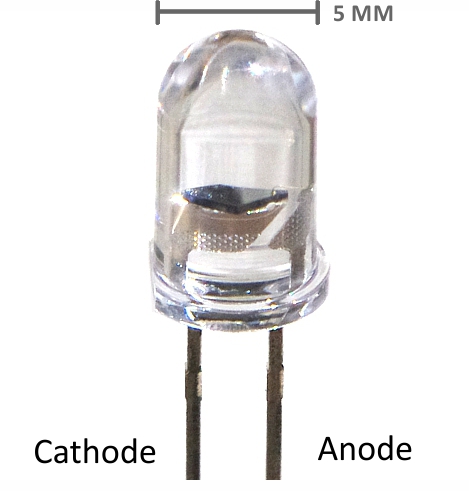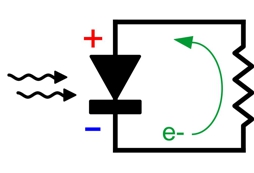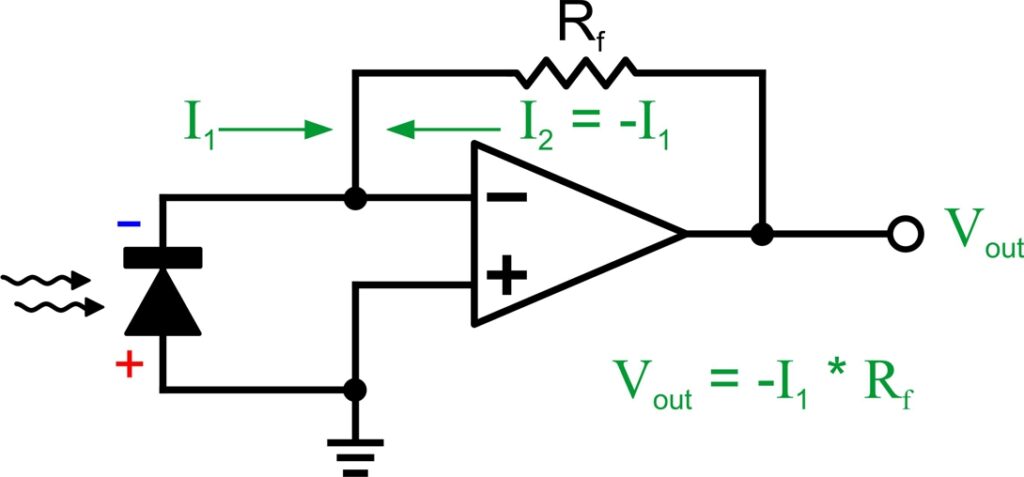Basics

What are photodiodes? These are semiconductor devices usually made from the element silicon. Photodiodes are employed as light sensors in many different essential technologies like fiber optic communications, smoke detectors, remote controls, etc. A photodiode works on the same principle as photovoltaic solar cells that are used to capture solar energy. In fact, a solar panel is basically an array of giant photodiodes. But when a sensor is needed, small size has advantages.
The sensors used in many Lite2Sound devices have an an active area of only 1 square millimeter. The active area looks like a square of black material. This material is silicon and it appears black because it absorbs visible light. Many photodiodes are encapsulated inside a drop of clear hard plastic resin, resembling a light emitting diode (LED) even though they’re actually light sensors. The dome shape of the encapsulating resin functions as a built-in lens to concentrate light onto the tiny silicon chip.

When light falls on a photodiode, the energy of light photons is absorbed in the silicon and transformed to electricity. Its anode terminal becomes positively charged, and its cathode becomes negative. The amount of current generated is proportional to the intensity of the light, and also depends on its color.
The wavelength of light is measured in nanometers (nm). Silicon (Si) photodiodes sense light of all visible colors, from deep blue (400 nm) to red (650 nm) to near infrared (1100 nm). In fact, they are most sensitive to infrared; the peak sensitivity of a Si photodiode sensor is at about 950 nm. It follows that the majority of infrared remote controls operate near this wavelength, since efficient infrared LED emitters are available to match.
Photodiodes that are made for use in IR remote controls have a dark colored lens, making them look like a black LED. The heavily tinted lens blocks visible light while allowing infrared to pass. You can see below the spectral sensitivity curves of two versions of the QSD2030 photodiode.

The plain QSD2030 has a clear lens and is responsive to light from 400 – 1100 nm. The dark-lensed QSD2030F (F- for “filtered”) attempts to block all visible light so it only responds to near-IR radiation in the 750 – 1100 nm range.
There are dozens of kinds of inexpensive silicon photodiodes in production, but most have nearly identical spectral response that cuts off at 1100 nm. For special uses at farther IR wavelengths, there are InGaAs (Indium Gallium Arsenide) photodiodes available with response to 1750 nm and even 2600 nm. This is the domain of sophisticated optical systems and laser imaging scanners like LIDAR. With a Lite2Sound device equipped with an InGaAs sensor, what kind of hidden technologies might you uncover? Who’s scanning whom?
On the opposite end of the spectrum, some types of photodiodes are sensitive to ultraviolet (UV) in the 200 – 400 nm range; therefore it’s conceivable you could equip a Lite2Sound device with one and search for audio concealed in ultraviolet light.
Converting light to electric signals

When light hits a photodiode in a circuit, an electric current is generated like in a solar panel. This is illustrated in the ultra-simple circuit above, which is just a photodiode with a resistor connected between its anode and cathode. From a 1 mm2 photodiode, the amount of current generated is much less than in a solar cell. For example, into a 100-ohm resistor, a QSD2030 photodiode produces only about 1/10,000th of an ampere under illumination by a desk lamp.
This particular circuit isn’t useful since all it does is convert light into an electric current, which it immediately disposes by just warming up a resistor. But to produce an electrical signal that can be used for audio, the circuit must include a scheme to convert current into voltage.
Transimpedance amplifiers
Transimpedance amplifiers (TIA) convert currents into a voltage output. In this application, the input current represents modulated light information. The voltage output represents an analog audio signal that we can listen to. A TIA is formed by adding a very common electronic device to the circuit above: an operational amplifier, or op amp.

The op amp’s job is to generate an output voltage, noted Vout. An op amp continuously adjusts Vout so there is no voltage difference between its (-) and (+) inputs. The resistor Rf in the circuit closes a negative feedback loop that makes this possible. While the photodiode is delivering a current I1 to the op amp’s (-) input, the op amp sends I2, an inverted copy of I1, back through the feedback resistor. When I1 and I2 add together, they cancel each other out, maintaining zero volts between the op-amp’s input terminals. So as the photodiode’s current I1 varies due to changing light input, the op-amp varies Vout along with it to preserve this balance through the principle of negative feedback. The result is a time-varying voltage that represents the amount of light falling on the photodiode. And as you already know, analog audio is a time-varying voltage.
The audio signal that we want, Vout, can be made louder or quieter by adjusting the feedback resistor Rf. You can understand by applying Ohm’s law, V = I * R, that the output voltage is the product of the photodiode’s current and the feedback resistor’s value in ohms. Therefore, the amplification factor, the voltage gain, of our photodiode amplifier is directly controlled by the value of Rf. Accordingly, more ohms means more gain, making a more sensitive receiver.
